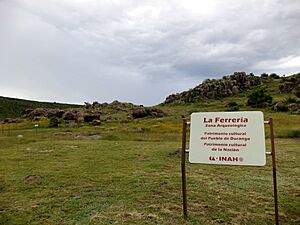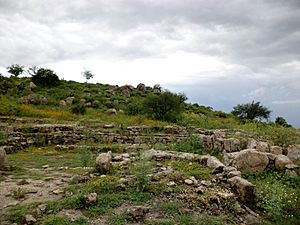La Ferrería facts for kids
Quick facts for kids Chalchihuites Culture – Archaeological Site |
||
| Name: | La Ferrería Archaeological site | |
| Type: | Mesoamerican archaeology | |
| Location: | City of Durango, Durango |
|
| Region: | Aridoamerica - Mesoamerica | |
| Coordinates: | 23°57′39″N 104°38′55″W / 23.96083°N 104.64861°W | |
| Culture: | Chichimec - Chalchihuites | |
| Language: | ||
| Chronology: | 875- 1450 CE | |
| Period: | Mesoamerican Classical - Postclassical | |
| INAH Web Page: | La Ferrería Archaeological site | |
La Ferrería is an important archaeological site in Mexico. It is located about 7 kilometers south of the City of Durango. You can find it on a hill called “Cerro de La Ferrería,” right next to the Tunal River.
The area around La Ferrería has many plants like mesquite and aloe. Animals like hares, rabbits, foxes, coyotes, squirrels, and lizards live here.
The first people to live in this region were the Nahua, who were nomads from North America. This was about 2,000 years ago. Later, between 875 and 1450 CE, the site was home to the Zacatecas people and the Tepehuanos.
The people who lived at La Ferrería mainly grew corn, beans, and squash. They also hunted and gathered food to complete their diet. Since the site is close to the Tunal River, fishing was likely a common activity too.
Archaeologists have found interesting things at the site. These include circular spaces used for rituals, bird bones, and stone rings. These finds suggest that La Ferrería had connections with cultures from the American Southwest, especially with a place called Paquimé. This might mean that cultures from northern Mesoamerica and the American Southwest mixed here.
Contents
Discovering La Ferrería's Past
The first known settlers at La Ferrería were the Nahuas, who arrived around 600 CE. They had migrated from other parts of North America. From 600 CE to 1450 CE, the Zacatecan and Tepehuano tribes also lived in this area.
La Ferrería was a special place where people gathered for religious events. They built pyramids, places of worship, and homes here. In 2007, a museum near La Ferrería was updated. It now displays many artifacts found at the site for visitors to see.
This region is a natural path through the Sierra Madre Occidental mountains. Many tribes, like the Toltec and Nahuatlaca, used this path. They used the natural stone formations in the wild territory to survive. These formations became safe places for tribes moving between Northern Mexico and the Valley of Anahuac. Over time, these tribes formed small communities, sharing language and region.
Some groups, like the Huichol, Cora, and Tarahumara Tepehuanos, formed distinct nations. They settled down and had strong family structures. They were different from the more warlike Chichimec tribe in central Mexico. However, the Acaxee, Humas, and Xiximes tribes were often at war. They were always looking for permanent settlements in the Quebradas region.
On the eastern side of the state, there is a long area stretching from Zacatecas to the Laguna area. The "Indios Laguneros" (Laguna Indians) moved freely in this area. They were known for being rebellious, unstable, and having unique religious customs. They were also hunters and gatherers. These native people were the first inhabitants of the region. Today, only a few Tepehuanos, Huicholes, Coras, and Tarahumara tribes remain.
Some experts believe that Mesoamerican cultures moved northward. This would mean that Oasisamerica cultures are related to their southern neighbors. The development of Oasisamerican cultures, like those in northern Mesoamerica, might be linked to groups from western Mexico. Archaeological findings suggest that Uto-Nahua groups brought farming to the Oasisamerican region. Even though farming techniques came from the south, Oasisamerican villages created their own unique civilization. They also kept in touch with Mesoamerican farmers.
It is important to remember that Durango is on the southern edge of the area influenced by the Mogollon and Anasazi cultures.
Exploring the Site
Spanish explorers first arrived in this area in 1531 with the Nuño de Guzmán expedition. In the following decades, especially under Francisco de Ibarra, many settlements were started. This happened further north of Zacatecas when silver was discovered. Ibarra named the new area Nueva Vizcaya, honoring his homeland of Biscay in the Basque Country. Nueva Vizcaya included the current states of Chihuahua and Durango. It also covered parts of eastern Sonora, Sinaloa, and southeastern Coahuila. This region was under the legal rule of the “Royal Guadalajara Audiencia.”
The first scientific information about La Ferrería came in 1948 from American anthropologist Alden Mason. Four years later, Charles Kelley and students from the University of Chicago began research. They found many archaeological pieces and wrote three reports.
We do not know where all the archaeological materials ended up. However, Kelley used them to figure out when people lived at the site. He suggested that the site was occupied between 800 and 1450 CE. He also thought it was connected to the Chalchihuites culture, specifically the Guadiana branch.
After Kelley's research, the site was left alone by authorities for 40 years. This led to damage and looting by people who illegally sold archaeological pieces. Since 1993, there have been only a few small investigations.
What You Can See at the Site
The site shows signs that at least two groups of people lived here. First, there was a nomadic group. Later, a settled group built the larger structures on the hill.
The people who lived at La Ferrería were part of the Chalchihuites culture. Their most important site was Altavista in Zacatecas. The group at La Ferrería was part of a branch called Guadiana. This branch reached as far north as El Zape in Durango.
The cultural group at La Ferrería mainly survived by farming corn, beans, and squash. They also hunted and gathered food.
Main Structures at La Ferrería
There are several important archaeological areas at La Ferrería. These include circular ritual spaces, a pyramid-like structure, a ballgame court, columns, and sunken patios.
House of Stepped Structures
This is a small area with a sunken patio. This type of patio was common in ancient buildings in this region. There are platforms on three sides of the patio. These were built with stone and clay, likely as foundations for older buildings. People also ground things in this area.
Governor's House
Experts believe the “Governor’s House” was used as a home. It has a sunken patio carved into large rocks. You can still see parts of the original walls and drains.
Like other structures, platforms surround it. These were probably foundations for houses made with tree trunk columns and grass roofs. These buildings are next to the columns hall and the small house.
Hall of Columns
The “columns hall” has remains of a small stone platform with large round columns. This was probably a meeting place, possibly used for rituals.
Colonial House
The “colonial house” is next to the columns hall. These are the foundations of a small, simple house, possibly from the colonial period. It was a single-room house with signs of metal melting.
House with Stone Floors
This house is at the top of the hill. You need to climb an old pathway to reach it. There are two fixed grinding stones here. These were probably used by a nomadic group and later by the farming groups.
At the House, halfway up the slope, there is a small sunken patio. One side was carved into the rock, forming two walls and the floor. In one corner, there is a fixed grinding stone.
Priests' House
The “Priests’ House” shows remains of house layouts, a water tank, and several drainage channels. There is also a pyramid base, likely for a temple. This structure is simple. It had stairs and ramps, plus a small sunken patio at the top.
Ballgame Court
This is one of the most damaged structures at the site. It has two parallel stone walls, which look like a ritual ballgame court. Inside, there are two stone stools and a platform, which was probably very large.
Ancient Rock Carvings (Petroglyphs)
There are two large rocks with carvings at the site:
One carving shows a small image of a priest with raised arms. The priest wears a ceremonial decoration with antlers. The rock was partly smoothed. This carving is the main feature of a small area used for worship. It might have been a place for protective gods.
The second carving is at the bottom of the hill. It is very worn, but you can still see a hunting scene. It shows a man with a bow, along with two animals.
Other Objects Found
Archaeologists found many objects at the site. These include pieces of pottery, complete stone tools like arrowheads, axes, and grinding stones.
La Ferrería Site Museum
The museum opened in 2000. It has two rooms displaying archaeological items from La Ferrería and the Chalchihuites culture. You can learn about their daily life, rituals, and how they interacted with other groups. The museum also shows the archaeological work done in the area.
You can see pottery with abstract designs, red-banded pottery, and some ceramic boxes. There are also large pots used for burials and obsidian knives.
See also
 In Spanish: La Ferrería para niños
In Spanish: La Ferrería para niños




